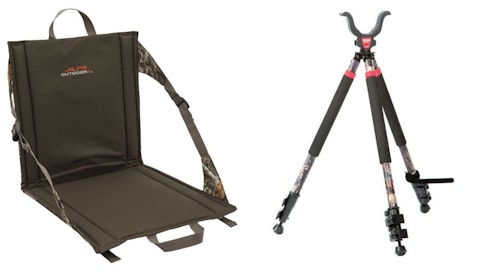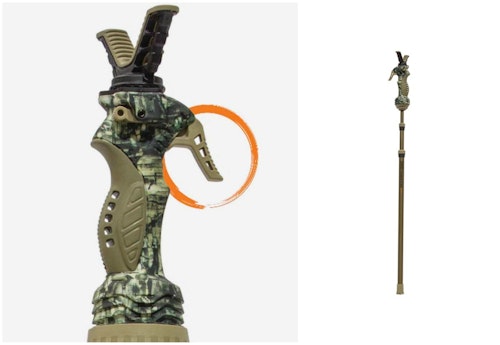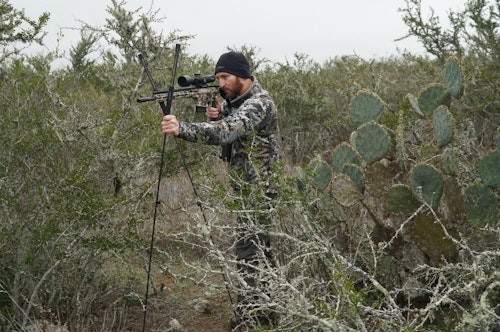When I started rifle hunting for whitetails in my home state of Minnesota 43 years ago, no one in our deer camp carried a shooting rest. While it’s true most shots in our flat, thickly forested area were less than 60 yards, there was a small chance at a 100-yard opportunity (examples: across a beaver pond, or down a logging road).
Dad taught my brother and me to rely on natural shooting rests whenever possible, and we practiced holding our centerfire rifles against the side of a tree, or on top of a blowdown. Even so, looking back at it now, we really should have carried a lightweight and effective shooting rest. Here are three reasons that quickly come to mind.
1. Immediate Access
During my early teens while still hunting whitetails in northern Minnesota, I learned there wouldn’t always be a handy sapling or blowdown nearby to utilize as a rifle rest when a shot presented itself. And taking just one or two more steps — on crunchy leaves, sticks or snow — to reach such a spot would’ve alerted the deer. Yes, hindsight is 20/20: Dad should have given me a lightweight shooting rest for hunting whitetails.
2. Better Gun-to-Rest Connection
I stated earlier that any shooting rest (tree trunk, blowdown) is better than nothing at all, but it’s also true the rubberized yoke of a high-quality, store-bought shooting rest is ideal. You shouldn’t rest the forearm of a gun directly on a hard surface such as timber because it can negatively affect your accuracy when firing. If you must use a blowdown, fence post, etc. for a rest, then place something soft (your hand, glove or backpack) under the firearm’s stock for a bit of cushioning. The rubberized yoke of a shooting rest works best because the firearm doesn’t slip in the yoke, the rest is solid, and the thin rubber provides the right amount of cushioning. Another advantage: You can practice with a store-bought gun rest before deer season so shooting from it becomes second nature.
3. Always the Correct Shooting Height
Think about it: A blowdown might work, but what if it’s too low or high, and you can’t get comfortable/steady behind the gun while aiming? Correct shooting rest height is critical to making a steady shot, so be sure your chosen rest works well for you and your style of hunting. Personally, I like the following designs and models.
Monopod: If I’m still hunting and the terrain dictates my shot is almost sure to be standing — and quick — then I opt for a Primos Gen3 Tall Monopod Trigger Stick ($85.99). I can adjust the height of this 2-pound shooting stick in a second with one hand by simply squeezing the trigger. It has a smooth panning action, and adjusts from 35 to 65 inches.
Bipod: Another option for standing shots is the lightweight (about a pound) Swagger Stalker Lite XL bipod ($99.99). Shown in the photo below, this system is almost as fast as the Primos monopod mentioned above, but because it’s a bipod instead of a monopod, it inherently provides a steadier shooting platform when needed (example: when longer shots are likely). The effective shooting height for the Stalker Lite XL is 45 to 65 inches. The bipod features Flex Ready Lite Technology, and rather than try to explain it in words, I suggest that you check out the video here to see it in action.
When I plan to shoot from a kneeling position, then I choose the shorter Swagger Stalker Lite bipod ($69.99) shown in the photo below. It works the same as its big brother the XL, but has an effective shooting height of 21 to 36 inches. Weighing only 10 ounces, the Stalker Lite is truly light!
Tripod: When maximum shooting stability is required, you can’t beat a tripod. There are several topnotch choices, and one of favorites is the BOG CLD 3S Short Camo Shooting Tripod ($76.99). The tripod’s Rapid Lock system makes it easy to adjust individual leg height, and screw-out spike feet can be deployed when needed depending on terrain. Useable height is 6 to 42 inches, which is ideal for sitting butt on the ground or on a short chair. Note: When sitting butt on the ground with my firearm resting on a tripod, it’s helpful to have back support. I like a stadium seat such as the ALPS OutdoorZ Backwoods ($29.99) for those times when I can’t lean my back against a tree.










